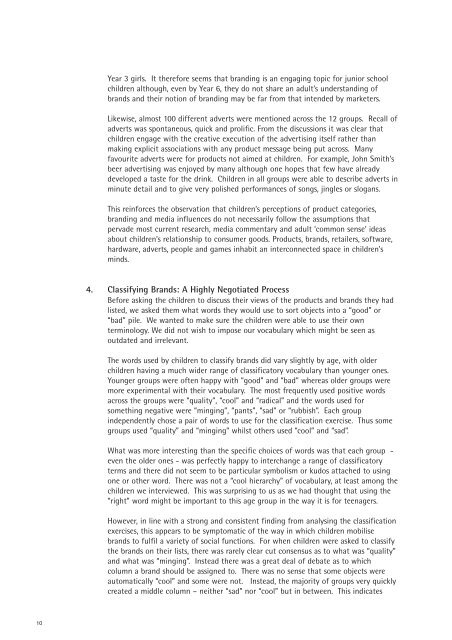The Simpsons are Cool but Barbie's a Minger - Professor Agnes Nairn
The Simpsons are Cool but Barbie's a Minger - Professor Agnes Nairn
The Simpsons are Cool but Barbie's a Minger - Professor Agnes Nairn
You also want an ePaper? Increase the reach of your titles
YUMPU automatically turns print PDFs into web optimized ePapers that Google loves.
10<br />
Year 3 girls. It therefore seems that branding is an engaging topic for junior school<br />
children although, even by Year 6, they do not sh<strong>are</strong> an adult’s understanding of<br />
brands and their notion of branding may be far from that intended by marketers.<br />
Likewise, almost 100 different adverts were mentioned across the 12 groups. Recall of<br />
adverts was spontaneous, quick and prolific. From the discussions it was clear that<br />
children engage with the creative execution of the advertising itself rather than<br />
making explicit associations with any product message being put across. Many<br />
favourite adverts were for products not aimed at children. For example, John Smith’s<br />
beer advertising was enjoyed by many although one hopes that few have already<br />
developed a taste for the drink. Children in all groups were able to describe adverts in<br />
minute detail and to give very polished performances of songs, jingles or slogans.<br />
This reinforces the observation that children’s perceptions of product categories,<br />
branding and media influences do not necessarily follow the assumptions that<br />
pervade most current research, media commentary and adult ‘common sense’ ideas<br />
about children’s relationship to consumer goods. Products, brands, retailers, softw<strong>are</strong>,<br />
hardw<strong>are</strong>, adverts, people and games inhabit an interconnected space in children’s<br />
minds.<br />
4. Classifying Brands: A Highly Negotiated Process<br />
Before asking the children to discuss their views of the products and brands they had<br />
listed, we asked them what words they would use to sort objects into a “good” or<br />
“bad” pile. We wanted to make sure the children were able to use their own<br />
terminology. We did not wish to impose our vocabulary which might be seen as<br />
outdated and irrelevant.<br />
<strong>The</strong> words used by children to classify brands did vary slightly by age, with older<br />
children having a much wider range of classificatory vocabulary than younger ones.<br />
Younger groups were often happy with “good” and “bad” whereas older groups were<br />
more experimental with their vocabulary. <strong>The</strong> most frequently used positive words<br />
across the groups were “quality”, “cool” and “radical” and the words used for<br />
something negative were “minging”, “pants”, “sad” or “rubbish”. Each group<br />
independently chose a pair of words to use for the classification exercise. Thus some<br />
groups used “quality” and “minging” whilst others used “cool” and “sad”.<br />
What was more interesting than the specific choices of words was that each group -<br />
even the older ones - was perfectly happy to interchange a range of classificatory<br />
terms and there did not seem to be particular symbolism or kudos attached to using<br />
one or other word. <strong>The</strong>re was not a “cool hierarchy” of vocabulary, at least among the<br />
children we interviewed. This was surprising to us as we had thought that using the<br />
“right” word might be important to this age group in the way it is for teenagers.<br />
However, in line with a strong and consistent finding from analysing the classification<br />
exercises, this appears to be symptomatic of the way in which children mobilise<br />
brands to fulfil a variety of social functions. For when children were asked to classify<br />
the brands on their lists, there was r<strong>are</strong>ly clear cut consensus as to what was “quality”<br />
and what was “minging”. Instead there was a great deal of debate as to which<br />
column a brand should be assigned to. <strong>The</strong>re was no sense that some objects were<br />
automatically “cool” and some were not. Instead, the majority of groups very quickly<br />
created a middle column – neither “sad” nor “cool” <strong>but</strong> in between. This indicates


